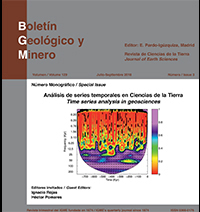Variability of the annual amounts of station precipitation revealed by autocorrelation functions and power spectra
DOI:
https://doi.org/10.21701/bolgeomin.129.3.002Keywords:
autocorrelation, nonlinear process, precipitation, rainfall, spectrum, suppressionAbstract
The rainfall in Seoul, comprising “Chugugi” and modern rain-gauge measurements, shows a resilient autocorrelation peak at a time lag of 11 years and a statistically reliable suppression of the 11-year frequency in the associated spectrum function. We confirmed a similar signature in the averages of the autocorrelations and spectra of the Global Historical Climatology Network precipitations. Approximately half of the selected 3,065 stations showed the autocorrelation peak, and the associated power suppression of the 11-year period or frequency. For the global average, the spectrum suppression was pronounced, and the associated correlation peak was less notable. We were able to simulate the suppression of power by modulating white noise time series representing precipitation with a sinusoidal time series of a given frequency. For modulation, we used multiplication instead of addition. The nonlinear process seems to be the principal mechanism in the influence of the 11-year solar cycle on precipitation.
Downloads
References
Balmforth, N. J., Provenzale, A., Spiegel, E., Martens, A., Tresser, C., and Wu, C. W., 1999. Red spectra from white and blue noise. Proceedings of the Royal B 266, 311-314. https://doi.org/10.1098/rspb.1999.0639 PMCid:PMC1689671
Chun, Y., and Jeon, S.-W., 2005. Chugugi, Supyo, and Punggi: Meteorological instruments of the 15th century in Korea. History of Meteorology 2, 25-36.
Friis-Christensen, E., and Lassen, K., 1991. Length of the solar cycle: An indicator of solar activity closely associated with climate. Science, 254, 698-700. https://doi.org/10.1126/science.254.5032.698 PMid:17774798
Gu, G., and Adler, R. F., 2011. Precipitation and Temperature Variations on the Interannual Time Scale: Assessing the Impact of ENSO and Volcanic Eruptions. Journal of Climate, 24, 2258-2270. https://doi.org/10.1175/2010JCLI3727.1
Hartmann, D. L., 1994. Global Physical Climatology. Academic Press, pp. 411.
Jung, H.-S., Lim, G.-H., and Oh, J.-H., 2001. Interpretation of the Transient Variations in the Time Series of Precipitation Amounts in Seoul, Korea. Part I: Diurnal variation. Journal of Climate, 14, 2989-3004. https://doi.org/10.1175/1520-0442(2001)014<2989:IOTTVI>2.0.CO;2
Jung, H.-S., Park, J.-S., Lim, G.-H., and Oh, J.-H., 2000. Trend analysis and wavelet transform of time series of precipitation including the Chukwookee observation in Seoul. The Korean Journal of Applied Statistics, 13, 525-540.
Kim, S. S., 1988. Comments on the Chinese claim for the invention of Chukwookee. Selected Papers of Kim, S. S., Hakye-Sa, 427-440. (In Korean).
Kim, S. S., 1976. A Study on Summer Precipitation and Winter Temperature at Seoul. Journal Korean Meteorological Society, 12, 1-5 (in Korean).
Kossin, J. P., Camargo, S. J., and Sitkowski, M., 2010. Climate modulation of North Atlantic hurricane tracks. Journal of Climate, 23, 3057-3076. https://doi.org/10.1175/2010JCLI3497.1
Labitzke, K., and van Loon, H., 1993. Some recent studies of probable connections between solar and atmospheric variability. Annals of Geophysics, 11, 1084-1094.
Lim, G.-H., Suh, Y.-C., and Kim, B.-M., 2006. On the Origin of the Tropical Atlantic Decadal Oscillation based on the Analysis of the ICOADS. Quarterly Journal of the Royal Meteorological Society, 132, 1139-1152. https://doi.org/10.1256/qj.05.01
Lim, G.-H., and Suh, A.-S., 2000. Diurnal and Semidiurnal Variations in the Time Series of 3-Hourly Assimilated Precipitation by NASA GEOS-1. Journal of Climate, 13, 2923-2940. https://doi.org/10.1175/1520-0442(2000)013<2923:DASVIT>2.0.CO;2
Parthasarathy, B., Rupa Kumar, K., and Munot, A. A., 1991. Evidence of secular variations in Indian monsoon rainfallcirculation relationships. Journal of Climate, 4, 927-938. https://doi.org/10.1175/1520-0442(1991)004<0927:EOSVII>2.0.CO;2
Torrence, C., and Compo, G. P., 1998. A Practical Guide to Wavelet Analysis. Bulletin of the American Meteorological Society, 79, 61-78. https://doi.org/10.1175/1520-0477(1998)079<0061:APGTWA>2.0.CO;2
van Loon, H., and Labitzke, K., 1998. The Global Range of the Stratosphere Decadal Wave. Part I: Its Association with the Sunspot Cycle in summer and in the Annual Mean, and with the Troposphere. Journal of Climate, 11, 1529-1537. https://doi.org/10.1175/1520-0442(1998)011<1529:TGROTS>2.0.CO;2
Wang, B., Jhun, J.-G., and Moon, B.-K., 2007. Variability and Singularity of Seoul, South Korea, Rainy Season (1778- 2004). Journal of Climate, 20, 2572-2580. https://doi.org/10.1175/JCLI4123.1
Wang, B., Ding, Q., and Jhun, J.-G., 2006. Trends in Seoul (1778-2004) summer precipitation. Geophysics. Res. Lett., 33, L15803. https://doi.org/10.1029/2006GL026418
Zhang, D., 1999. Climate Variation of Wetness in Eastern China over the Past Millennium. Bulletin of the National Museum of Japanese History, 81, 31-39.
Downloads
Published
How to Cite
Issue
Section
License
Copyright (c) 2024 Consejo Superior de Investigaciones Científicas (CSIC)

This work is licensed under a Creative Commons Attribution 4.0 International License.
© CSIC. Manuscripts published in both the print and online versions of this journal are the property of the Consejo Superior de Investigaciones Científicas, and quoting this source is a requirement for any partial or full reproduction.
All contents of this electronic edition, except where otherwise noted, are distributed under a Creative Commons Attribution 4.0 International (CC BY 4.0) licence. You may read the basic information and the legal text of the licence. The indication of the CC BY 4.0 licence must be expressly stated in this way when necessary.
Self-archiving in repositories, personal webpages or similar, of any version other than the final version of the work produced by the publisher, is not allowed.
Funding data
Korea Meteorological Administration
Grant numbers 2014-3062















